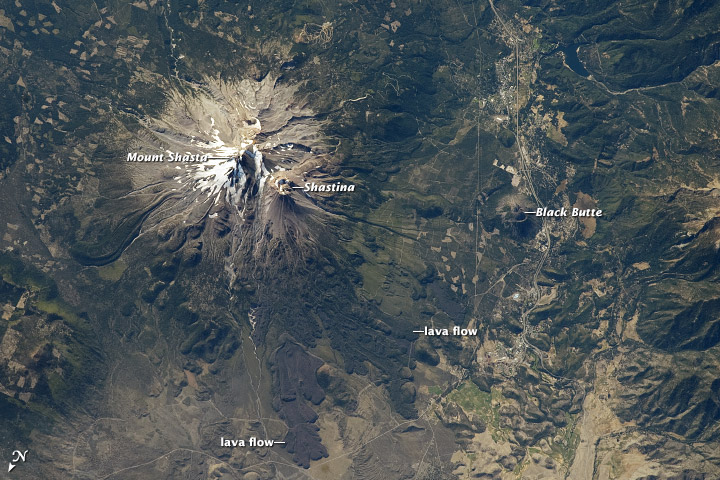Oh, yes, my darlings. We will haz him. Little by little, we will suck him in, until he becomes the Bad Astrogeologist. Mwah-ha-ha!
So here he is, with a spectacular photo of Mount Shasta taken from the International Space Station, and yes – it’s delish. I present here the labeled version for volcano-from-space viewing pleasure.
- Mount Shasta from the ISS. Image taken September 20th, 2012. Image courtesy NASA.
Go. Read the post. Savor the line at the end: “I love volcanoes, and I’m fascinated by them.” This, my darlings, is our opening.*
Hence, I act whilst Phil is still in a volcano-dazzled state, and present a photo of Mount St. Helens from the ISS.
- Mount St. Helens from Space. Compare and contrast with Shasta, which did not recently suffer a sector collapse and directed blast. As NASA sez, “The devastating effects of the eruption are clearly visible in this 2002 photo from the International Space Station.” Ayup, that they are. Image courtesy NASA.
And suggestively link to the dramatic story of the events leading up to the big boom that turned her from a Shasta-like cone to what she is today: a shell of her former self.** This is what is known as “setting the hook.” Heh.
As further evidence that our Bad Astronomer could easily become our Bad Astrogeologist, I present to you: bouncing moon rocks. And Mars rocks. And Mars sand.
Yeah. Phil knows geology ain’t limited to Earth science. If it’s rocky, it’s ours – whether it’s an Earth volcano from space, a planet, a moon, a meteor… it’s geology! In space!
Even astronomers can’t help falling in love.
I look forward to more geology-in-space goodness at Phil’s new digs. It’s just too bad I didn’t have the chance to lobby for a name as well as venue change…
*Actually, we’ve had that for a long time – Phil knows geology and astronomy are two great sciences that taste great together. See: meteorites.
**I realized recently that I can sum up the St. Helens eruption very simply and accurately. My best friend mentioned something about how scientific papers should come in understandable language. I told him that’s what I’m here for: to translate scientific prose into everyday words. Such as, “Mountain fall down, go boom.” I always said that as a joke, but it’s actually what happened: sector collapse (volcano fall down) followed by a lateral eruption (go boom). This is why I love geology, people. Okay, one of the million trillion reasons I love geology. Many of even its most complex aspects can be understood without too many mental gymnastics, and explained to a layperson without making them wish to flee. Some of the other sciences have a bit more of a challenge in that department.








